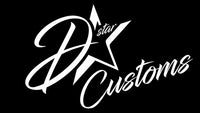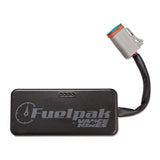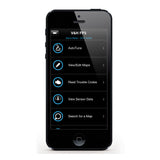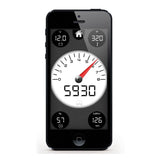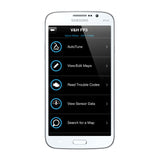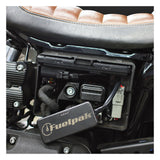The latest in digital communication with your bike's fuel injection system is done via bluetooth with your smartphone, either Android or iPhone.
Flash technology is used to recalibrate the OEM fuel map.
The OEM fuel map will be stored in the FP3 so the ECU can always be returned to OEM factory condition.
Stationary manual adjustments will let you adjust the fuel map, EITMS (Engine Idle Temperature Management System) and idle speed, AFR (Air Fuel Ratio) can be set slightly richer or leaner.
Ignition timing can be adjusted and includes a rev limiter.
New maps can be downloaded from Vance & Hines and through the on-bike sensors the system can be run in AutoTune mode, which enables the bike to recalibrate the fuel map real time to the specific conditions and even the quality of fuel that is used.
When the Android or iPhone is installed on the bike, live sensor data, like speed, RPM, cylinder head temperature, voltage, gear selection etc. can be seen on the display of the smartphone.
Note: Once the FP3 is used on a bike it is 'mated' to that specific OEM ECU.
You will not be able to use the same FP3 on another bike.
The OEM fuel map is stored in the FP3, therefore the ECU can always be returned to the OEM factory set-up.
Fits: >
11-20 Softail (excl. 11-13 & 16-20 CVO);
12-17 Dyna (excl. 12-13 CVO);
14-20 Touring/CVO;
16-20 Freewheeler;
14-20 Sportster;
15-20 Street XG500/750/750A
IMPORTANT NOTICE – D-Star Racewear and Customs / Messrs Johnson accept no responsibility for any mechanical issues that your vehicle whilst using a custom exhaust.
With the correct fitment and fuel tuning (if you have an fp3 please see the product info for setup) these will operate to perfect conditions.
any issues with setup, you can utilise V&H excellent customer service who will help amend and tweak maps for any custom exhaust along with their own V&H off the shelf setups.
It is your responsibility to ensure your bike is road legal at all times and all parts meet local laws.
Vehicles should be have all parts and bolts checked after the first 50 miles of use, then every 100-150 miles after to ensure everything is fastened correctly and in good operational order.
